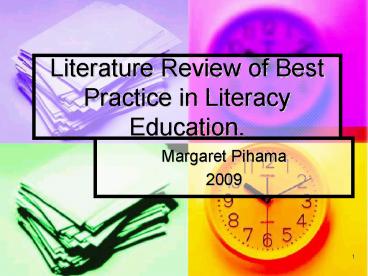Literature Review of Best Practice in Literacy Education. - PowerPoint PPT Presentation
1 / 24
Title:
Literature Review of Best Practice in Literacy Education.
Description:
Title: Literature Review of Best Practice in Literacy Education. Author: Ministry of Education Last modified by: Ministry of Education Created Date – PowerPoint PPT presentation
Number of Views:136
Avg rating:3.0/5.0
Title: Literature Review of Best Practice in Literacy Education.
1
Literature Review of Best Practice in Literacy
Education.
- Margaret Pihama
- 2009
2
Outline of Review
- Best Practice in general Education
- Best Practice in Deaf Education in various
settings - How Best Practice in Literacy is promoted
3
General Education
- Literacy Taskforce endorsed principles of best
practice for teaching reading and writing in New
Zealand schools. - A statement of best practice needs to be quite
specific about what comprises appropriate
instructional approaches,
4
The Literacy Taskforce endorsed the following
principles of best practice
- a sound understanding of the learning process
that underpins all teaching - the expectation that all children will become
successful readers and writers - language programmes that acknowledge the
interrelationship and reciprocity of oral,
written, and visual language
5
The Literacy Taskforce endorsed the following
principles of best practice (contd)
- planning for teaching that will build on the
childs existing skills, knowledge, interests,
and individual needs and that will acknowledge
the role of the child as an active learner - teaching that takes account of childrens
linguistic and cultural backgrounds
6
The Literacy Taskforce endorsed the following
principles of best practice (contd)
- teaching that uses a range of explicit and
implicit instructional strategies appropriate to
the learner, including small-group or individual
instruction where appropriate - regular and purposeful monitoring childrens
progress in reading and writing being monitored
regularly (using running records, teacher
conferencing, observation, and other methods) for
clear purpose and for use in subsequent teaching
7
The Literacy Taskforce endorsed the following
principles of best practice (contd)
- the development of positive attitudes to reading
and writing, including the willingness to take
risks - the use of a wide range of interesting material,
fiction and non-fiction, in a range of media and
appropriate to the instructional levels,
including repetitive texts, rhymes, poems, and
songs, to enhance childrens print and
phonological awareness
8
The Literacy Taskforce endorsed the following
principles of best practice (contd)
- access to a wide range of interesting and
stimulating material, fiction and non-fiction in
a range of media - teachers who are readers and writers.
9
Teachers reduce risks for children and take risks
- Are aware of the students backgrounds
- Have high expectations
- Tailor instructions to needs
- Recognise and value the knowledge and strengths
of the students - Are culturally relevant teaching aimed at
excellence
10
Learning about Language
- Language and literacy development is intertwined.
- Language and literacy are communication.
- Learning to read and write is the most important
language dependent task children face.
11
Communication Components
- Communication Act
- Mode of the Act speech/sign
- Structure of the Act- grammar
- Context or meaning- semantics
- Purpose or Pragmatic intent
12
Settings and Perspectives in Deaf Education
- Reading
- Writing
- Whole language
- Bi-lingual
- Oral
- Assessment
- Itinerant setting
13
Literacy Best PracticesBrenda Stephenson
(University of Tennessee)
- Provide and monitor level-appropriate reading
materials for independent reading activities as
well as time to read - Use technology such as CDs, captioned materials,
and interest based Internet sites that are known
to be motivating
14
- 3. Teach phonemic awareness and phonics either
through structured auditory-based programs with
appropriate modifications for oral students or
through specialised materials and techniques that
provide visual support to students who sign or
need additional visual support
15
- 4. Teach metacognitive skills such as reading
strategies prior to, during, and after reading
through Guided Reading activities to promote text
comprehension.
16
- 5. Promote reading development through written
language applications such as dialogue journals,
research reading and writing, language experience
stories, writing to read, or other language based
programmes.
17
- 6.Use content. area reading materials to promote
reading comprehension through scaffolding and
other content area techniques - 7. Have students collaborate with others on
activities that promote literacy development
through such activities as shared reading and
writing
18
- 8. Teach vocabulary meaning though semantic-based
activities that enhance knowledge of multiple
meanings of words, idiomatic expressions, and
concrete and abstract meanings of words.
19
- 9. Teach vocabulary meaning through
morphographemic based activities that enhance
knowledge of word meaning through understanding
of root words, prefixes, suffixes, including
Latin and Greek derivatives.
20
- 10. Incorporate specific activities and
strategies to promote either spoken reading
fluency in oral students or signed reading
fluency in signing students.
21
Promoting Best Practices in Literacy
- Professional development
- Standards for training, and competency
- The Join Together Project online knowledge bank,
Master Teachers and a Manual for support and
guidance - Mentoring and peer review
- Research
22
Research
- Teachers treat it as a source of good ideas
- Researchers think teachers
- should apply its findings
- (Graham Nuthall
- University of Canterbury)
23
Now.
- Options
- Professional development programme
- Identify examples of best practice in literacy
instruction at KDEC. - Manual of examples of best practice in literacy
instruction - Mentoring/peer review programmes
- Use of the KDEC website as resource,
- eg. a question/answer format.
- Master Teachers Project scenario
24
References
- Stephenson, B. (2006). Language Across the
Curriculum. www.deafed.net/PublishedDocs/Teacher_E
xcellence_in_General_and_Deaf_Ed.doc - Ministry of Education. (1999). Report of the
Literacy Taskforce. www.minedu.govt.nz/educationSe
ctors/Schools/ResearchAndStatistics - www.defed.net































